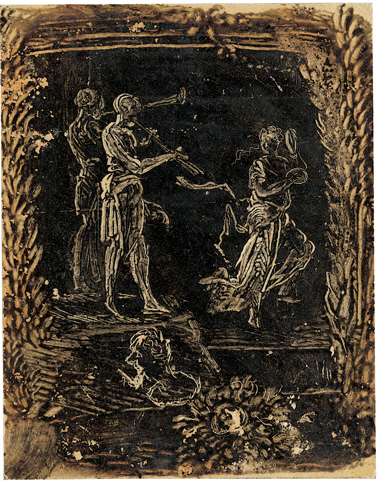Loading the page ...
Carl Blechen
(1798 Cottbus – 1840 Berlin)
Two flute players with a dancing maenad. “Smoke drawing” (drawing scratched into lamp-black fixed onto paper). 8.8 x 6.9 cm. Mounted by the artist on grayish-green prepared board with a blue and brown borderline. Signed on the verso: Blechen.
The present drawing is an absolute curiosity within the oeuvre of Carl Blechen. On a ground of lamp-black or soot, Blechen scratched with fluid strokes a small, delightful composition. It shows a dancing maenad in a flowing chiton (antique dress) playing a tambourine. To her left are two flute-playing youths in short tunics. Both stand on a small elevation into which the profile head of a bearded man has been scratched with a few lines. The entire scene is bordered by a leafy frame. Iconographically the drawing suggests ancient Roman decorative painting. The light lines on a dark ground look like the grotesque ornaments found on Roman wall paintings of a type also present in Pompeii. Blechen might well have seen comparable motifs during his travels to Rome and southern Italy in 1828–29, during which he also visited the ancient city of Pompeii. The technique of the “smoke picture” might have been invented by the artist himself. Most likely it was a singular experiment, since no other works of this type can be found in Blechen’s work.
Provenance: On the verso of the sheet is an annotation in an old hand in pencil: K. Blechen / (Rauchbild) / Lpz. Auct. 1870 / Mai 9ff / no 3161. This refers to an auction held by the firm of Rudolph Weigel in Leipzig on May 9, 1870 that was accompanied by a catalogue titled Katalog der reichen Kunstsammlung des Herrn Christian Schuchardt. Our sheet is listed there as lot 3161. The monogram SC in pencil on the verso of the mount of our drawing can therefore be interpreted as the collector’s monogram of Johann Christian Schuchardt (1799–1870). Schuchardt worked from 1825 as secretary to Johann Wolfgang von Goethe and became known mainly for the catalogue of Goethe’s art collection that was published in Jena in 1848.
An expertise by Prof. Helmut Börsch-Supan from June 21, 2004 accompanies the drawing.
